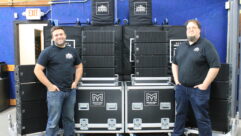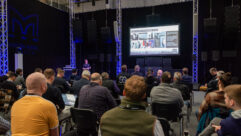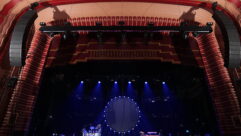A Martin Audio OmniLineA® system has been specified and installed at Central Railway Station in Sydney, the largest in Australia, to conquer a speech intelligibility problem that has persisted for years.
The Country Trains Concourse, measuring 360 ft x 196 ft x 32 ft with a challenging RT60 time of 5.5 seconds in the mid-band, has long defied attempts to get intelligible announcements heard by commuters. Over the years, many brands have successively tried and failed to tame the inherent reverberation caused by a combination of terrazzo floors, sandstone and plate glass walls and a high arched steel roof.
Last year Glenn Leembruggen, principal of Acoustic Directions, became the latest specialist to do battle with the acoustically hostile environment.
Since acoustic treatment of the inside of the roof was ruled out as being financially untenable, two members of the Acoustic Directions team, David Connor and David Gilfillan, decided to trial several software-driven systems and different steerable line array solutions.
They ultimately concluded that a Martin Audio OmniLine system, with DSP processing, would produce the best quality and best speech clarity. They duly specified 120 steered elements supplied by TAG, Martin Audio’s Australian distributors.
Modular and scalable, this particular OmniLine installation used a special version of the Martin Audio Display software (operating under an FIR filtering scheme that addressed every element in the array with its own processed channel). The intelligent software enabled the array to be configured to deliver sound precisely over the venue’s vertical profile without spillage. Furthermore, elimination of high-frequency side-lobes gives OmniLine an advantage over conventional DSP steered columns making it suitable for high quality speech and music reproduction even in reverberant spaces such as railway station concourses.
Acoustic Directions were thus able to simultaneously optimize the direct field over the listening area, keep the sound off reflective rear walls, and minimise reverberant sound power. The result is remarkably high intelligibility throughout the concourse, even at rush hour, when as many as 3,000 passengers are adding to the cacophony of noise resonating around this vast cavern.
With the amps situated as much as 650 ft away from the speakers, a 100 Volt system was required, and Acoustic Directions worked with Harbuch Electronics to develop a 100V loudspeaker transformer that was ultra-flat and with only 10 degrees of phase shift at 20kHz. The FIR filters that beam control the array are implemented in Nion processors with the loudspeakers being driven by 8-channel 2.4kW amplifiers (to provide 120 amp channels).
Acoustic Directions optimized the frequency responses over the listening area using time-windowed impulse responses.
The installation also picked up a coveted Rutledge AV Industry Award (an AVIA) with the judges commending Acoustic Directions’ meticulous implementation of the modelling, installation and commissioning of the system.
As a result, for the first time not only can amplified speech be easily understood in any part of the concourse, but music and pre-recorded messages sound natural and clear—and roaming hand-held wireless microphones can function without fear of feedback.
In fact, such is the confidence inspired by this new solution, that special events, promotions and even live music events are being hosted at Sydney’s Central Railway Station, using the house system!
For more about Martin Audio, please click to
.
About Martin AudioA®
Founded by audio engineer David Martin in 1971, Martin Audio pioneered the use of all-horn-loaded bass designs in world-class touring loudspeaker systems for groups such as Pink Floyd, ELP and Supertramp. Located outside of London, Martin Audio now embodies a sophisticated mix of acoustic design, research, mathematical modeling and software engineering for a wide range of products in the installation, cinema and touring sound markets.
About OmniLineA®
OmniLine is a versatile, micro-line array designed for installation in a wide variety of architectural environments. Its modular approach and scalability extend its use from foreground applications to sound reinforcement in large acoustic spaces. Intelligent software enables an array to be configured to deliver sound precisely over any vertical angle to fit the venue profile without spilling onto surfaces where sound is not required. Additionally, elimination of high-frequency side-lobes gives OmniLine the advantage over currently available DSP steered columns, making it suitable for high quality music reproduction as well as speech in large, reverberant spaces. Each array is constructed by connecting multiple modules. Up to 32 modules can be connected where both high output and vertical focusing down to low/mid frequencies are required. Smaller number of modules (down to 4) can be used for shorter-throw applications, where vertical focusing of the low/mid frequencies is less important. This scalability means that OmniLine can be used in a variety of applications. Visually, an OmniLine array is slim and unobtrusive, with soft lines that minimize its visual presence in an architectural environment.










